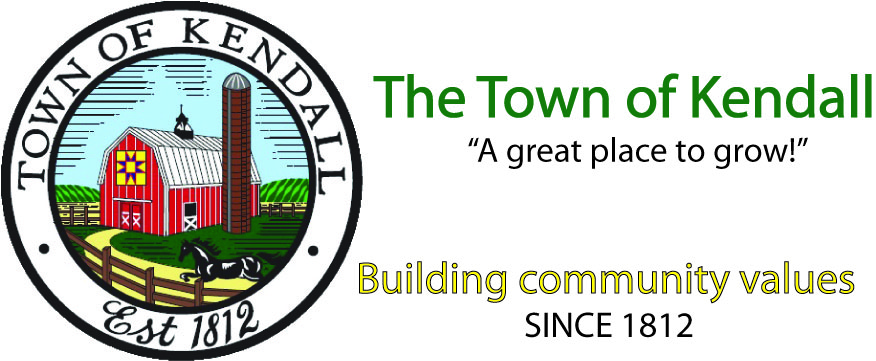Information:
1873 Kendall Road
Kendall New York, 14476
Phone: 585.659.8721
Fax: 585.659.8203
TDD/NYS Relay: 800.662.1220
Building Hours
Monday, Tuesday, Thursday, Friday: 9:00 am to 3:30 pm
(Closed for lunch from noon to 1:00pm)
Monday Nights: 7:00 pm to 9:00 pm
Closed Wednesdays
The Town of Kendall was named in honor of Amos Kendall, the United States Postmaster General at the time the Township was formed. On April 7, 1837, about half of the Town of Murray became the new Town of Kendall. Settlements were not built as early as in other towns on the Holland Purchase because it was off the line of travel and had not been surveyed into lots and formally put on the market. The State of Connecticut and the Pultney Estate had owned these lands, under a joint title, and for a considerable time they remained undivided.
In July 1812, Dr. Levi Ward became an agent for the State of Connecticut, to sell their land on the 100,000-acre tract – of which Kendall forms a part. In 1811 a formal partition of land between the State of Connecticut and the Pultney Estate was made and Joseph Fellows was appointed agent of the Pultney Estate.
Samuel Bates from Vermont is said to have been the first white man to settle in this town, locating on lot 111 in East Kendall (now Morton) in 1812. He cleared some land and sowed wheat but did not move his family in until 1814.
David Jones, Adin Manley, Amos Randall, John Farnsworth, Zebulon Rice, Benjamin Morse and Nathaniel Brown settled in 1815. Felix Augur, Rev. Stephen Randall, Ansel Balcom, George Balcom, Stephen Bliss and James Weed arrived in 1816. And Eathan Graham, William and his son, Robert Clark, came in 1817.
The first marriage in the town was James Aiken to Esther A. Bates, March 2, 1817. The first birth was Bartlett B. Morse, in November 1815, and the first death was the son of George Balcom in 1816.
Hiram Thompson opened the first store in 1823. Augur and Boyden built the first sawmill in 1819, and Gurdon Balcom taught the first school in 1819. Ose Webster built the first gristmill in what is now Kendall Mills.
Elder Stephen Randall, a Methodist preacher, conducted the first religious service. The first physician in town was Dr. Theophilus Randall.
Early settlers had to travel from Ridge Road in Clarkson north, to what is now Hamlin, then west – until a road was built from Kendall Mills following the west side of Sandy Creek to the Ridge Road.
The first settlers experienced hardships that we can only imagine. Most of them came from the mountains of Vermont and the change of climate, air, water, food and occupation in this comparatively level country had consequences. Before the clearing of land, there was dense forest in the area. Many suffered from a malaria-type disease called Ague, propagated by the moist forest floor.
The Erie Canal opened in 1825 making a ready market for wheat and lumber. It also made the way easier for more settlement. A group of 52 Norwegians came from Stavanger Norway and made the first Norwegian settlement in the New World. They settled in a body along the lakeshore in the northeast part of town. Eventually, the majority of them followed their leader, Cleng Peerson, to Illinois and what they perceived at the time as “greener pastures”. A few families remained here and there are reminders of their presence here in Kendall to this day.
The Town of Kendall is an equal opportunity provider and employer. To file a complaint of discrimination write to: USDA, Assistant Secretary for Civil Rights, Office of the Assistant Secretary for Civil Rights, 1400 Independence Ave., S.W., Stop 9410 Washington, DC 20250-9410. Or call toll-free at 866-632-9992 (English) or 800-877-8339 (TDD) or 866-377-8642 (English Federal-relay) or 800-845-6136 (Spanish Federal-relay).

